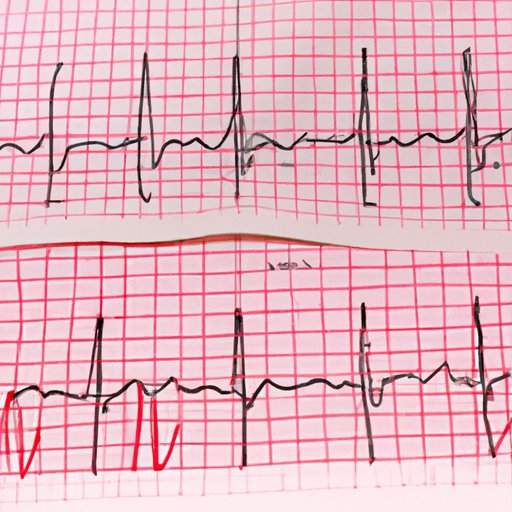
Introduction
When it comes to your cardiovascular health, stress tests are a crucial tool that doctors use to detect underlying issues and ensure that your heart is functioning properly. But if you’ve never had a stress test before, the idea of undergoing this examination can be intimidating. In this article, we’ll explore what stress tests are, how they work, and what patients can expect during a stress test procedure.
Putting Your Heart to the Test: Understanding the Science Behind Stress Tests
A stress test, also known as an exercise electrocardiogram, is a type of test that measures the response of your heart to physical exertion. Stress tests are performed to check for various cardiac conditions like coronary artery disease (CAD), heart rhythms like atrial fibrillation or ventricular tachycardia (VT).
To understand how a stress test works, it’s important to have a basic understanding of the science behind it. During a stress test, you will be asked to exercise on a treadmill or stationary bike while connected to an electrocardiogram (ECG) machine. As your heart beats faster and your blood pressure increases, the ECG records the electrical activity of your heart.
Through this recording, doctors are able to identify abnormalities in your heart’s rhythm and determine if there is a decreased blood flow to your heart muscles, which could indicate the presence of blocked or narrowed arteries.
From Treadmills to EKGs: The Step-by-Step Guide to Stress Tests
If you are scheduled for a stress test, it’s important to know what to expect from the procedure.
The first step of the test starts with the preparation, which includes not eating or drinking anything except for water beforehand. People who have diabetes should consult with their doctor for specific instructions.
During the test, you will exercise on a treadmill or stationary bike at an increasing intensity level until you reach your maximum heart rate. The test is performed while you’re hooked up to ECG, so the machine can monitor the activity of your heart throughout the testing process.
If you are unable to exercise due to other constraints like joint pain, walking difficulty or shortness of breath, doctors may perform a pharmacological stress test. In this type of test, you will be given medication (like Dobutamine or Adenosine) to simulate the effects of exercise on your heart. This type of test may take longer than the treadmill test and require closer monitoring of your heart rate and blood pressure.
Breaking Down Stress Tests: What to Expect During the Procedure
During the test, you may experience fatigue, shortness of breath, muscle soreness, or chest pain. If these symptoms become severe, or if you experience any other unusual symptoms, the test will be stopped immediately.
One of the most common anxieties patients have about stress tests is the possibility of having a heart attack during the procedure. However, the risk of having a heart attack or serious complication as a result of a stress test is extremely low, less than one percent.
Why Your Heart Needs a Stress Test: Exploring the Importance of Cardiovascular Health
Stress tests are essential to maintaining good cardiovascular health, helping to identify blockages or other heart conditions early on so you can take the necessary steps to prevent complications.
According to the American Heart Association, cardiovascular disease is the leading cause of death in the United States, accounting for more than 800,000 deaths every year. Stress tests play a vital role in helping to identify the early stages of cardiovascular disease, allowing doctors to take proactive measures to prevent further damage.
Beyond the Heart Rate: How Stress Tests Detect Underlying Health Issues
Stress tests can detect not only underlying heart issues but also other health conditions like high blood pressure, coronary artery disease, peripheral artery disease, or an irregular heartbeat. Early detection of these conditions allows for prompt treatment before the condition becomes more severe or causes significant damage.
After the stress test, doctors analyze the recorded data and compare it to your previous test results if you’ve had any. This helps determine the progression of the condition and help decide if you need further testing like angiography or medications to regulate your heart rate, pressure, or cholesterol levels.
The Benefits and Risks of Stress Tests: What Patients Need to Know
Like with any medical procedure, there are potential risks and benefits to stress testing. It’s important to understand these factors before undergoing the procedure.
Benefits of stress tests include the early detection of health issues, which can lead to prompt treatment and a better prognosis. These tests are essential for maintaining good cardiovascular health and can help reduce the risk of heart failure, heart attack, or stroke.
However, there are potential risks involved with stress tests, including false positives, complications from the procedure, and the possibility of false negatives. It’s important to talk with your doctor about any concerns you have related to the benefits and risks of stress testing.
Demystifying Stress Tests: A Comprehensive Guide to Your Heart’s Examination
Stress testing may seem intimidating at first, but it’s a vital tool that can help you maintain good cardiovascular health. By understanding what to expect during a stress test and the science behind the procedure, you can approach the examination with confidence.
Remember, if you’re ever feeling anxious or worried about the stress test, feel free to talk to your doctor or the healthcare professionals performing the procedure. They’re there to support you and ensure that you’re comfortable throughout the testing process.
Conclusion
Stress testing is an essential part of maintaining good cardiovascular health, allowing doctors to detect and identify underlying health issues before they become more severe. By knowing what to expect during a stress test and understanding the science behind the procedure, you can take the necessary steps to protect your heart.





